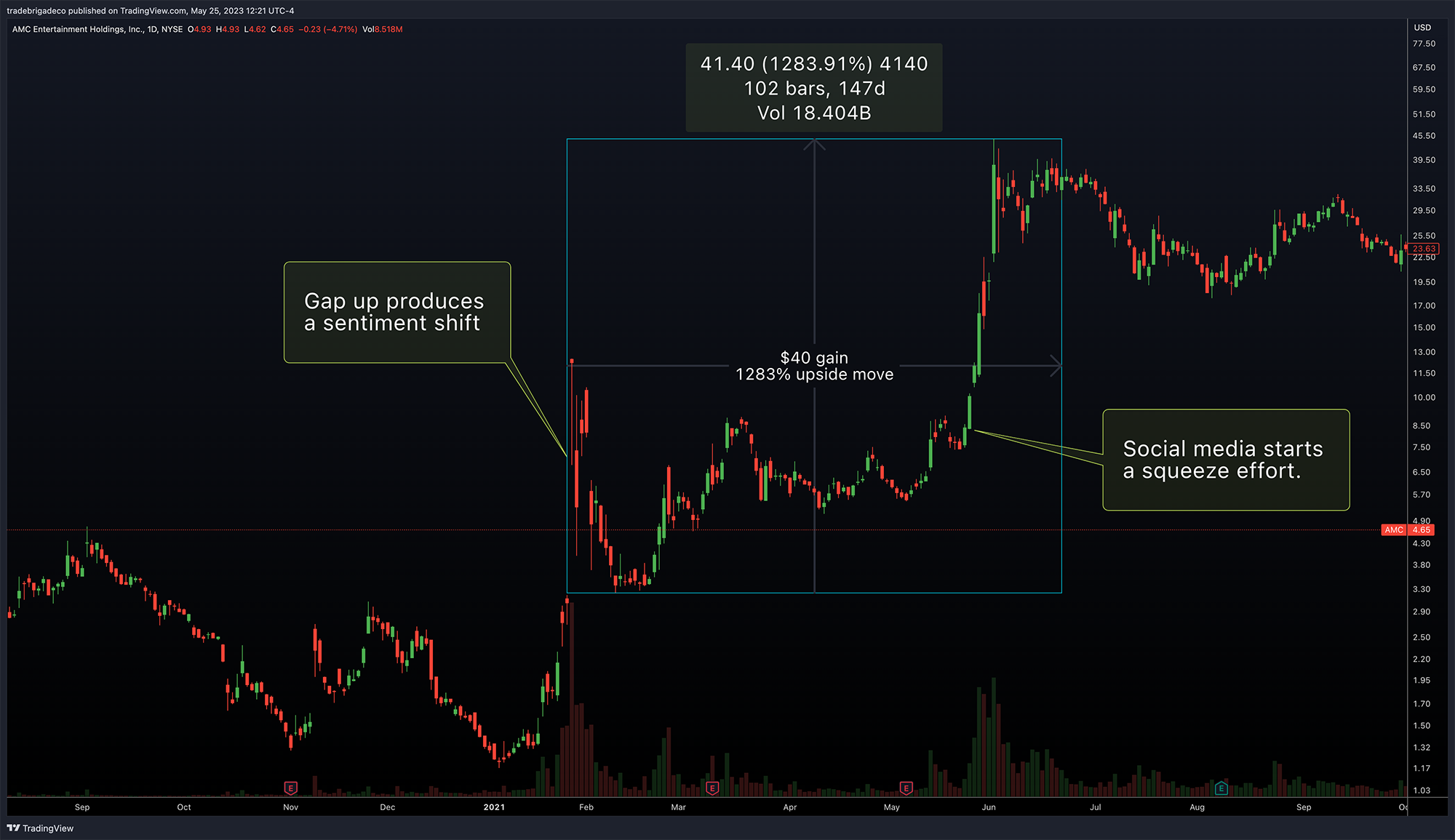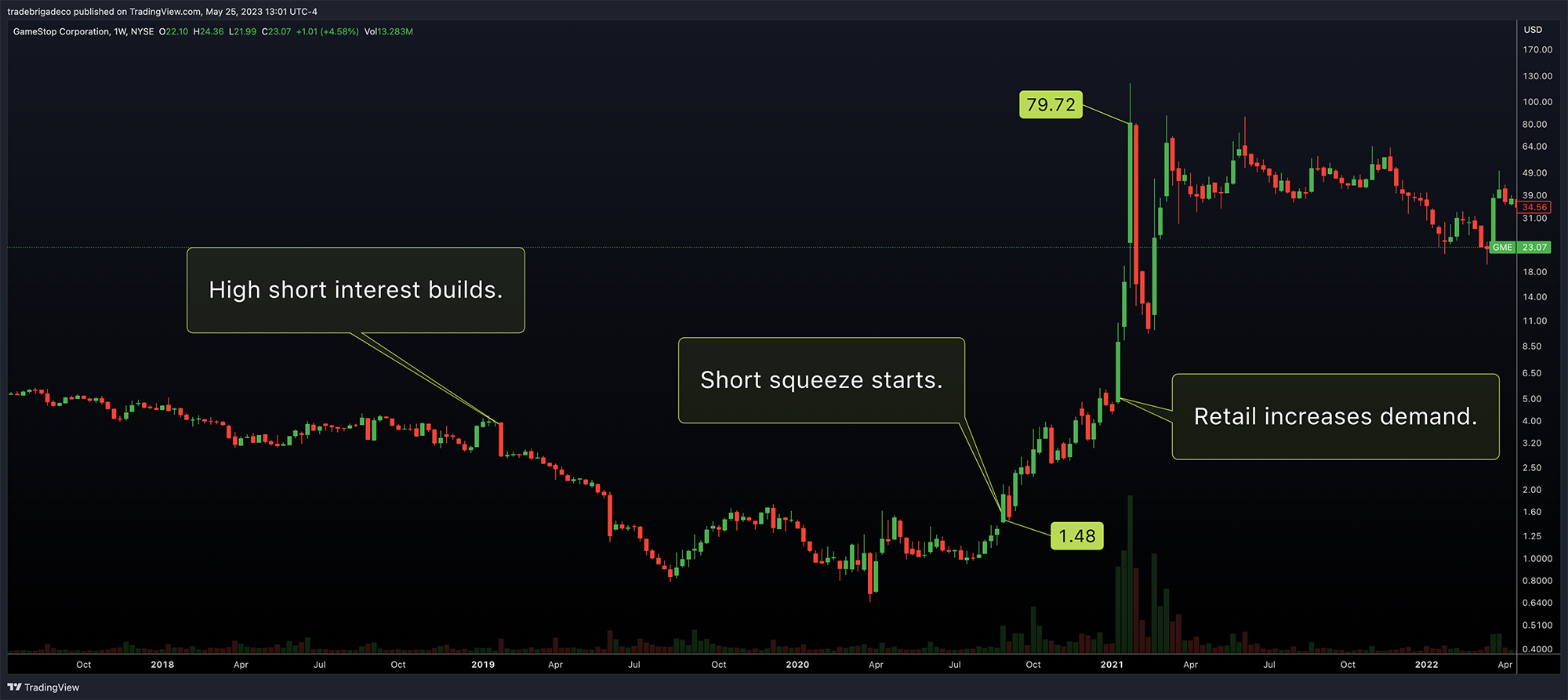What is a Short Squeeze?
Causes and Implications
GME (Gamestop) chart with short squeeze stages identified. Price moved over 6000%, perhaps one of the most legendary short squeezes in all of history.
What is a Short Squeeze?
A short squeeze is a rapid increase in the price of a stock that occurs when short sellers are forced to buy back their shares to close the position due to an increase in buying pressure to avoid taking a larger loss. Before diving into the intricacies of short squeezes, let’s first understand the mechanics of short selling.
Understanding Short Selling
Short selling is a trading strategy used by investors and traders alike, who want the price of a particular stock to go down. Short sellers borrow shares of that stock from a broker on margin and sell them on the market to collect the initial premium. Short sellers then aim to buy the shares they borrowed back at a lower price in the future, thus profiting from the price difference if the intended price decline takes place. If prices rise, the seller is forced to buy shares back at a higher price and must pay the difference as a net loss.
How Does a Short Squeeze Happen?
When a short squeeze occurs, usually the price of a stock starts to rise rapidly from some outside catalyst. As we know, short sellers want stock prices to go down to make a profit. The faster and more unexpected the move in the upward direction is, the more likely it is that a short squeeze will take place. This is because short sellers will potentially be forced to buy back their shares at the current market price, even if it is higher than the price they originally sold them at, to avoid a margin call. This increased buying pressure from short covering can drive the price of the stock even higher, creating a positive feedback loop causing more shorts to cover, thus continuing to drive prices higher.
Short squeezes can stem from several underlying causes:
- Positive News Catalyst: Positive news regarding a company’s fundamentals, new product launches, or strategic partnerships can trigger increased buying interest, catching short sellers off guard and fueling a short squeeze.
- Limited Supply and High Demand: If the supply of shares available for trading is limited while demand surges, it creates a supply-demand imbalance, which can lead to a short squeeze as short sellers rush to cover their positions.
- Coordinated Buying Efforts: In some cases, organized groups of retail traders or online communities, fueled by social media platforms, may coordinate buying campaigns targeting heavily shorted stocks, amplifying the squeeze effect.
Perhaps the most famous example is on AMC. Keep in mind that the below image uses a logarithmic price scale and price traveled from roughly $3 to $43, representing roughly a 1283% move in the upward direction.

How Do You Identify Potential Short Squeezes?
There are a few things that traders can do to identify potential short squeezes. These include:
- Looking for stocks with high short interest. Short interest is the number of shares that have been borrowed and sold short. A high short interest indicates that there are a lot of short sellers betting that the price of the stock will go down. Check out this article here on how to use Finviz to scan for this criteria. Click Here
- Looking for stocks that have been sold off recently. Stocks that have been declining in price are more likely to be targeted by short sellers and have a higher short interest.
- Looking for stocks that have recently received positive news catalysts. Positive news can trigger a short squeeze by causing investors to buy shares, which can drive the price up and force short sellers to cover their positions. Generally this must be paired with a stock that already has a high short interest.
Traders who anticipate and position themselves correctly during a short squeeze can potentially see large profits as the price escalates rapidly. However, timing and risk management are crucial in these volatile situations. Nine out of ten times, once you’ve already identified a squeeze, it is too late to be a buyer. Because of this, chasing short squeezes is NOT a suitable strategy for most market participants. You are more likely to get hurt in a short squeeze instead of seeing a monumental career making trade unfold.
Short squeezes often inject a high degree of volatility into markets, gaining attention from traders looking to take advantage of price movement. Generally volume will increase and during the day or two of the squeeze, and liquidity will be high. Issues arise after the squeeze if volume dries up, and nobody is interested in trading the stock anymore. Large bid ask spreads may be present when the liquidity vanishes, making it unreasonable to trade the stock without taking large losses on the spread.
Conclusion
Short squeezes are thrilling emotional events that can disrupt the natural movement of markets and present opportunities both up and down for traders. Of course, we can’t have our cake and eat it too, and these opportunities also come with elevated risk. More often than not, avoiding short squeezes will serve you well. Understanding the causes and implications of short squeezes will help you make informed decisions and navigate the volatility from a more responsible perspective. Whether you choose to ride the wave or exercise caution, staying vigilant and adaptable is key to success in the ever volatile stock market.

